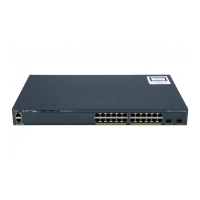13-12
Catalyst 2960 and 2960-S Switches Software Configuration Guide, Release 15.0(1)SE
OL-26520-01
Chapter 13 Configuring VLANs
Configuring Extended-Range VLANs
• STP is enabled by default on extended-range VLANs, but you can disable it by using the no
spanning-tree vlan vlan-id global configuration command. When the maximum number of
spanning-tree instances are on the switch, spanning tree is disabled on any newly created VLANs.
If the number of VLANs on the switch exceeds the maximum number of spanning-tree instances,
we recommend that you configure the IEEE 802.1s Multiple STP (MSTP) on your switch to map
multiple VLANs to a single spanning-tree instance. For more information about MSTP, see
Chapter 17, “Configuring MSTP.”
• Although the switch stack supports a total of 255 (normal-range and extended-range) VLANs, the
number of configured features affects the use of the switch hardware. If you try to create an
extended-range VLAN and there are not enough hardware resources available, an error message is
generated, and the extended-range VLAN is rejected.
• In a switch stack, the whole stack uses the same running configuration and saved configuration, and
extended-range VLAN information is shared across the stack.
Creating an Extended-Range VLAN
You create an extended-range VLAN in global configuration mode by entering the vlan global
configuration command with a VLAN ID from 1006 to 4094. The extended-range VLAN has the default
Ethernet VLAN characteristics (see Table 13-2) and the MTU size, and RSPAN configuration are the
only parameters you can change. See the description of the vlan global configuration command in the
command reference for the default settings of all parameters. In VTP version 1 or 2, if you enter an
extended-range VLAN ID when the switch is not in VTP transparent mode, an error message is
generated when you exit VLAN configuration mode, and the extended-range VLAN is not created.
In VTP version 1 and 2, extended-range VLANs are not saved in the VLAN database; they are saved in
the switch running configuration file. You can save the extended-range VLAN configuration in the
switch startup configuration file by using the copy running-config startup-config privileged EXEC
command. VTP version 3 saves extended-range VLANs in the VLAN database.
Beginning in privileged EXEC mode, follow these steps to create an extended-range VLAN:
Command Purpose
Step 1
configure terminal Enter global configuration mode.
Step 2
vtp mode transparent Configure the switch for VTP transparent mode, disabling VTP.
Note This step is not required for VTP version 3.
Step 3
vlan vlan-id Enter an extended-range VLAN ID and enter VLAN configuration mode.
The range is 1006 to 4094.
Step 4
mtu mtu-size (Optional) Modify the VLAN by changing the MTU size.
Note Although all VLAN commands appear in the CLI help, only the
mtu mtu-size, and remote-span commands are supported for
extended-range VLANs.
Step 5
remote-span (Optional) Configure the VLAN as the RSPAN VLAN. See the
“Configuring a VLAN as an RSPAN VLAN” section on page 27-18.
RSPAN is supported only if the switch is running the LAN Base image.
Step 6
end Return to privileged EXEC mode.

